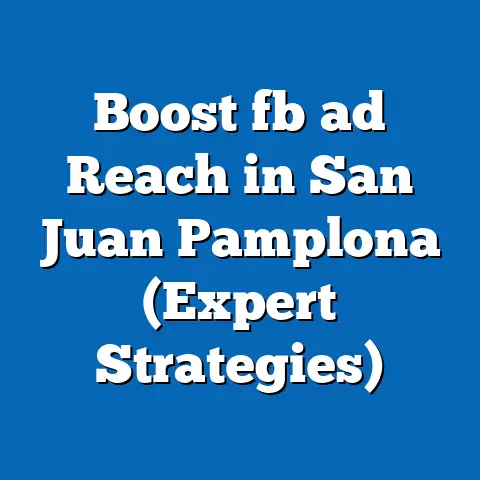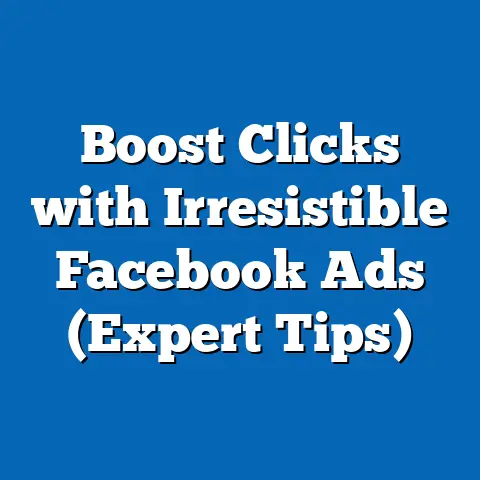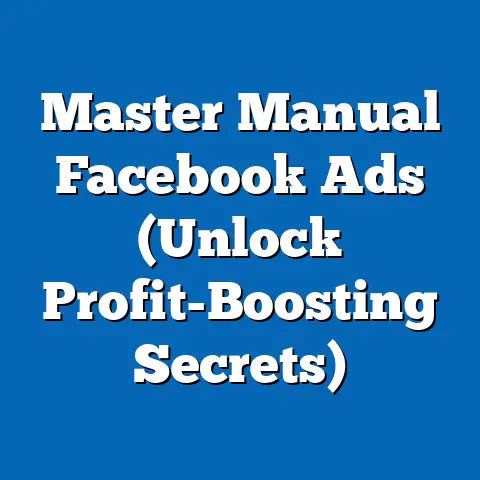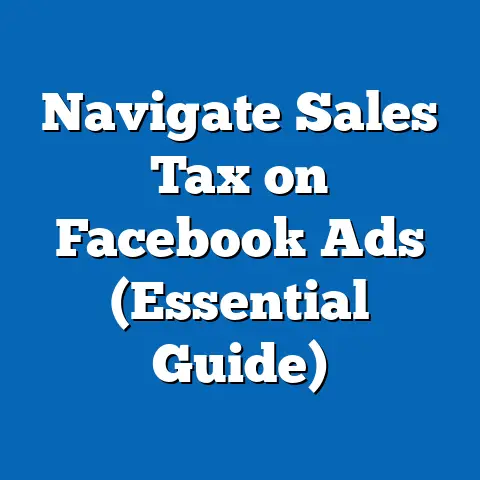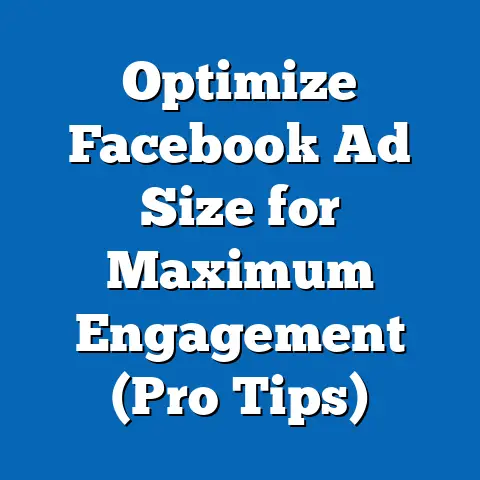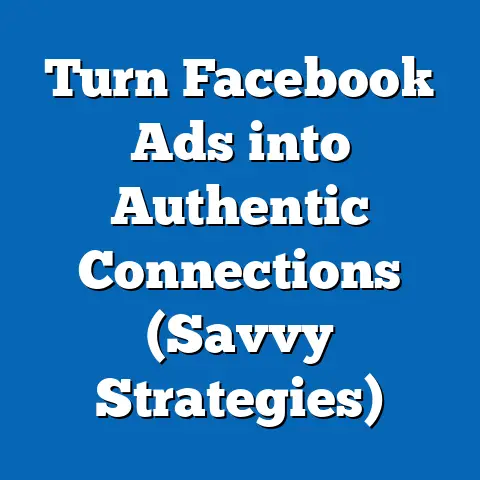Unlock 0.01 CPM Facebook Ads Success (Expert Strategies)
I still remember the day I cracked the code on a Facebook ad campaign for a local bakery. They were struggling to get the word out about their new line of artisanal breads, and their ads were barely making a dent. After weeks of tweaking and testing, I finally hit a sweet spot: a combination of hyper-local targeting, mouth-watering visuals, and compelling copy that spoke directly to the neighborhood’s foodies. The result? A CPM (Cost Per Mille) that dipped to an unbelievable $0.01. It wasn’t just about the money saved; it was about the sheer volume of people we reached and the buzz it created in the community. That’s when I realized the true potential of Facebook advertising, and it’s what I want to share with you today. Achieving a CPM that low isn’t magic; it’s a science. It’s about understanding the platform, your audience, and the art of crafting ads that resonate.
1. Understanding CPM (Cost Per Mille)
CPM, or Cost Per Mille (Mille being Latin for thousand), is the amount you pay for one thousand impressions of your ad. An impression is counted each time your ad is displayed to a user, regardless of whether they click on it or not. It’s a fundamental metric in Facebook advertising, as it directly impacts the reach and visibility of your campaigns.
Why is CPM Important?
CPM is important because it is the foundation on which you can measure the efficiency of your campaigns.
- Cost Efficiency: A lower CPM means you’re paying less to reach a larger audience. This can significantly reduce your overall advertising costs and improve your ROI.
- Brand Awareness: High visibility at a low cost allows you to build brand awareness without breaking the bank.
- Benchmarking: CPM is a useful metric for comparing the performance of different campaigns, ad sets, and targeting options.
- Optimization: Monitoring CPM helps you identify areas for improvement in your ad creatives, targeting, and bidding strategies.
How is CPM Calculated?
The formula for calculating CPM is simple:
CPM = (Total Ad Spend / Total Impressions) x 1000
For example, if you spend $100 on an ad campaign and it generates 100,000 impressions, your CPM would be:
CPM = ($100 / 100,000) x 1000 = $1
Factors Influencing CPM
Several factors can influence your CPM on Facebook:
- Audience Targeting: Highly specific and niche audiences tend to have higher CPMs due to increased competition. Broader audiences generally have lower CPMs.
- Ad Quality: Facebook’s algorithm rewards high-quality ads with lower CPMs. This includes factors like relevance score, engagement rate, and user feedback.
- Ad Placement: Different ad placements (e.g., News Feed, Instagram Feed, Audience Network) have varying CPMs.
- Bidding Strategy: Your bidding strategy (e.g., lowest cost, target cost, bid cap) can impact your CPM.
- Seasonality: CPMs tend to fluctuate based on the time of year. For example, CPMs are typically higher during the holiday season due to increased competition.
- Industry: Some industries are more competitive than others, leading to higher CPMs.
- Ad Relevance: Ads that are highly relevant to the user’s interests and needs tend to have lower CPMs.
- Competition: The more advertisers targeting the same audience, the higher the CPM will be.
- Time of Day: CPMs can vary based on the time of day, with peak hours typically having higher costs.
Takeaway: Understanding CPM is crucial for optimizing your Facebook ad campaigns. By monitoring and analyzing your CPM, you can identify areas for improvement and make data-driven decisions to lower your advertising costs.
2. The Importance of Targeting
Targeting is the cornerstone of successful Facebook advertising. It’s not enough to have a great product or service; you need to get it in front of the right people. Facebook’s powerful targeting capabilities allow you to reach specific audiences based on a wide range of factors.
Targeting Options on Facebook
Facebook offers a variety of targeting options:
- Demographics: Target users based on age, gender, location, education, relationship status, job title, and more.
- Interests: Target users based on their interests, hobbies, and passions. Facebook gathers this information from the pages they like, the content they engage with, and the topics they discuss.
- Behaviors: Target users based on their online and offline behaviors, such as purchase history, device usage, travel habits, and more.
- Custom Audiences: Create custom audiences based on your existing customer data, such as email lists, website visitors, and app users.
- Lookalike Audiences: Expand your reach by creating lookalike audiences that are similar to your existing customers. Facebook identifies the common characteristics of your source audience and finds new users who share those traits.
- Saved Audiences: Allows you to save a specific audience that you can use for multiple campaigns. This is useful if you have a well-defined target audience that you want to reach consistently.
Expert Strategies for Building a Low-CPM Audience
Here are some expert strategies for building an audience that not only lowers your CPM but also improves engagement rates:
- Hyper-Local Targeting: If you’re targeting a local audience, focus on specific neighborhoods or zip codes. This can significantly lower your CPM and increase relevance.
- Layered Targeting: Combine multiple targeting options to create a highly specific audience. For example, you could target women aged 25-34 who are interested in yoga and live in a specific city.
- Exclusion Targeting: Exclude certain audiences from your targeting to avoid wasting ad spend on users who are unlikely to convert. For example, you could exclude existing customers from your prospecting campaigns.
- Website Custom Audiences: Target users who have visited specific pages on your website. This allows you to tailor your ads to their interests and needs.
- Engagement Custom Audiences: Target users who have engaged with your Facebook content, such as liking your page, watching your videos, or clicking on your ads.
- Detailed Demographics: Go beyond basic demographics and target users based on their life events, parental status, or relationship status.
- Interest Expansion: Allow Facebook to expand your interest-based targeting to reach users who are similar to your target audience but may not have explicitly expressed those interests.
- A/B Testing: Continuously test different audience segments to identify the most effective targeting options.
A/B Testing Your Audiences
A/B testing is crucial for optimizing your audience targeting. Here’s how to approach it:
- Create Multiple Ad Sets: Create multiple ad sets with different targeting options.
- Split Your Budget: Divide your budget evenly between the ad sets.
- Run Your Ads: Run your ads for a sufficient period (e.g., 7-14 days) to gather enough data.
- Analyze the Results: Analyze the performance of each ad set, focusing on metrics like CPM, click-through rate (CTR), conversion rate, and cost per conversion.
- Optimize: Pause the underperforming ad sets and allocate more budget to the top performers.
- Repeat: Continuously test and refine your audience targeting to improve your results.
Example:
Let’s say you’re promoting a new line of organic skincare products. You could create two ad sets:
- Ad Set 1: Target women aged 25-44 who are interested in organic skincare and live in a specific city.
- Ad Set 2: Target women aged 25-44 who are interested in natural beauty and live in the same city.
After running your ads for a week, you analyze the results and find that Ad Set 1 has a lower CPM and a higher conversion rate. You would then allocate more budget to Ad Set 1 and continue to test other targeting options to further optimize your results.
Takeaway: Effective targeting is essential for achieving a low CPM and maximizing your ROI on Facebook. By leveraging Facebook’s targeting options and continuously testing different audience segments, you can reach the right people with the right message at the right time.
3. Crafting Compelling Ad Creatives
Even with perfect targeting, your ads won’t perform well if your creatives are lackluster. Compelling ad creatives are essential for capturing attention, driving engagement, and ultimately lowering your CPM.
Elements of a Compelling Ad Creative
A compelling ad creative typically includes the following elements:
- Eye-Catching Visuals: Use high-quality images or videos that are relevant to your product or service.
- Persuasive Copy: Write clear, concise, and compelling copy that highlights the benefits of your offer.
- Strong Call to Action: Tell users what you want them to do (e.g., “Shop Now,” “Learn More,” “Sign Up”).
- Relevance: Ensure your ad creative is relevant to your target audience’s interests and needs.
- Value Proposition: Clearly communicate the value you’re offering to the user.
- Brand Consistency: Maintain a consistent brand identity across all your ad creatives.
Best Practices for Visuals
- High-Quality Images: Use high-resolution images that are visually appealing and professionally shot.
- Video is King: Videos tend to perform better than static images, as they capture attention and convey more information.
- Mobile-First Design: Design your visuals with mobile users in mind, as most Facebook users access the platform on their phones.
- Use Bright Colors: Bright and vibrant colors can help your ads stand out in the News Feed.
- Showcase Your Product: Highlight your product or service in a visually appealing way.
- Use Text Overlays Sparingly: Avoid using too much text in your visuals, as this can reduce their effectiveness.
Best Practices for Copy
- Keep it Concise: Get straight to the point and avoid using jargon or technical terms.
- Highlight Benefits: Focus on the benefits of your product or service, rather than just the features.
- Use Strong Verbs: Use action-oriented verbs that encourage users to take action.
- Ask Questions: Engage users by asking questions that are relevant to their interests.
- Create Urgency: Use language that creates a sense of urgency, such as “Limited Time Offer” or “While Supplies Last.”
- Personalize Your Message: Tailor your copy to your target audience’s interests and needs.
Ad Formats and Their Best Uses
Facebook offers a variety of ad formats:
- Image Ads: Simple and effective for showcasing a single product or service.
- Video Ads: Great for capturing attention and conveying more information.
- Carousel Ads: Allow you to showcase multiple products or services in a single ad.
- Collection Ads: Designed for e-commerce businesses, allowing users to browse and purchase products directly from the ad.
- Instant Experience Ads: Full-screen, mobile-optimized ads that provide an immersive experience.
Example:
Let’s say you’re promoting a new fitness app. Here are some creative ideas:
- Image Ad: Use a high-quality image of someone using your app at the gym, with copy that highlights the app’s key features and benefits.
- Video Ad: Create a short video that demonstrates how the app works and showcases its user-friendly interface.
- Carousel Ad: Showcase different workout routines available in the app, with each carousel card featuring a different exercise and its benefits.
- Instant Experience Ad: Create a full-screen experience that allows users to explore the app’s features, watch demo videos, and sign up for a free trial.
Takeaway: Compelling ad creatives are essential for capturing attention, driving engagement, and lowering your CPM. By using high-quality visuals, persuasive copy, and a strong call to action, you can create ads that resonate with your target audience and deliver results.
4. Leveraging Facebook’s Algorithm
Facebook’s algorithm is a complex system that determines which ads are shown to which users. Understanding how the algorithm works and how to leverage it is crucial for achieving a low CPM.
How Facebook’s Algorithm Works
Facebook’s algorithm aims to provide users with the most relevant and engaging content possible. This means that ads are evaluated based on a variety of factors, including:
- Relevance Score: A metric that measures how relevant your ad is to your target audience. The higher your relevance score, the lower your CPM will be.
- Engagement Rate: The percentage of users who engage with your ad (e.g., likes, comments, shares, clicks). Higher engagement rates indicate that your ad is resonating with your audience, which can lower your CPM.
- Ad Frequency: The number of times a user sees your ad. High ad frequency can lead to ad fatigue, which can negatively impact your relevance score and CPM.
- Bidding Strategy: Your bidding strategy can impact your CPM. For example, using a cost cap bidding strategy can help you control your CPM.
- Landing Page Experience: The quality and relevance of your landing page can impact your ad performance. If users have a poor experience on your landing page, it can negatively impact your relevance score and CPM.
Strategies for Leveraging the Algorithm
Here are some strategies for leveraging Facebook’s algorithm to achieve a lower CPM:
- Improve Your Relevance Score:
- Target the Right Audience: Ensure your ads are targeted to the most relevant audience.
- Create High-Quality Creatives: Use compelling visuals and persuasive copy that resonate with your audience.
- Test Different Ad Formats: Experiment with different ad formats to see which ones perform best with your audience.
- Monitor User Feedback: Pay attention to user feedback on your ads and make adjustments as needed.
- Increase Engagement Rates:
- Ask Questions: Encourage users to engage with your ads by asking questions.
- Run Contests and Giveaways: Generate excitement and engagement by running contests and giveaways.
- Use Interactive Ad Formats: Experiment with interactive ad formats like polls and quizzes.
- Respond to Comments: Engage with users who comment on your ads to foster a sense of community.
- Manage Ad Frequency:
- Monitor Your Frequency: Keep an eye on your ad frequency to ensure users aren’t seeing your ads too often.
- Rotate Your Creatives: Regularly update your ad creatives to prevent ad fatigue.
- Use Frequency Capping: Limit the number of times a user sees your ad within a specific period.
- Optimize Your Landing Page:
- Ensure Relevance: Make sure your landing page is relevant to your ad and your target audience.
- Improve User Experience: Ensure your landing page is easy to navigate and provides a positive user experience.
- Optimize for Mobile: Ensure your landing page is optimized for mobile devices.
- Track Conversions: Track conversions on your landing page to measure the effectiveness of your ads.
- Target the Right Audience: Ensure your ads are targeted to the most relevant audience.
- Create High-Quality Creatives: Use compelling visuals and persuasive copy that resonate with your audience.
- Test Different Ad Formats: Experiment with different ad formats to see which ones perform best with your audience.
- Monitor User Feedback: Pay attention to user feedback on your ads and make adjustments as needed.
- Ask Questions: Encourage users to engage with your ads by asking questions.
- Run Contests and Giveaways: Generate excitement and engagement by running contests and giveaways.
- Use Interactive Ad Formats: Experiment with interactive ad formats like polls and quizzes.
- Respond to Comments: Engage with users who comment on your ads to foster a sense of community.
- Monitor Your Frequency: Keep an eye on your ad frequency to ensure users aren’t seeing your ads too often.
- Rotate Your Creatives: Regularly update your ad creatives to prevent ad fatigue.
- Use Frequency Capping: Limit the number of times a user sees your ad within a specific period.
- Ensure Relevance: Make sure your landing page is relevant to your ad and your target audience.
- Improve User Experience: Ensure your landing page is easy to navigate and provides a positive user experience.
- Optimize for Mobile: Ensure your landing page is optimized for mobile devices.
- Track Conversions: Track conversions on your landing page to measure the effectiveness of your ads.
Takeaway: Understanding and leveraging Facebook’s algorithm is crucial for achieving a low CPM. By focusing on relevance, engagement, and user experience, you can create ads that the algorithm favors and that deliver results.
5. Scaling Campaigns Effectively
Scaling your Facebook ad campaigns while maintaining a low CPM requires careful planning and execution. It’s not enough to simply increase your budget; you need to do it strategically.
Techniques for Scaling Campaigns
Here are some techniques for scaling your Facebook ad campaigns:
- Budget Optimization:
- Gradual Scaling: Increase your budget gradually over time to avoid disrupting the algorithm.
- Campaign Budget Optimization (CBO): Allow Facebook to automatically allocate your budget across your ad sets based on performance.
- Ad Set Budget Optimization (ABO): Manually allocate your budget to each ad set based on performance.
- Lookalike Audiences:
- Expand Your Reach: Create lookalike audiences to reach new users who are similar to your existing customers.
- Layer Targeting: Layer lookalike audiences with other targeting options to refine your reach.
- Test Different Seed Audiences: Experiment with different seed audiences to find the most effective lookalike audiences.
- Sequential Retargeting:
- Target Users Based on Their Behavior: Retarget users based on their behavior on your website or app.
- Create a Funnel: Create a retargeting funnel that guides users through the customer journey.
- Personalize Your Message: Tailor your retargeting ads to the user’s specific interests and needs.
- Broad Targeting:
- Expand Your Audience: Expand your targeting to reach a broader audience.
- Let Facebook Optimize: Allow Facebook to optimize your ad delivery to find the most relevant users within your broad audience.
- Monitor Performance: Closely monitor the performance of your broad targeting campaigns to ensure they’re delivering results.
- Gradual Scaling: Increase your budget gradually over time to avoid disrupting the algorithm.
- Campaign Budget Optimization (CBO): Allow Facebook to automatically allocate your budget across your ad sets based on performance.
- Ad Set Budget Optimization (ABO): Manually allocate your budget to each ad set based on performance.
- Expand Your Reach: Create lookalike audiences to reach new users who are similar to your existing customers.
- Layer Targeting: Layer lookalike audiences with other targeting options to refine your reach.
- Test Different Seed Audiences: Experiment with different seed audiences to find the most effective lookalike audiences.
- Target Users Based on Their Behavior: Retarget users based on their behavior on your website or app.
- Create a Funnel: Create a retargeting funnel that guides users through the customer journey.
- Personalize Your Message: Tailor your retargeting ads to the user’s specific interests and needs.
- Expand Your Audience: Expand your targeting to reach a broader audience.
- Let Facebook Optimize: Allow Facebook to optimize your ad delivery to find the most relevant users within your broad audience.
- Monitor Performance: Closely monitor the performance of your broad targeting campaigns to ensure they’re delivering results.
Analyzing Campaign Data
Analyzing your campaign data is crucial for making informed decisions about scaling your campaigns. Here are some key metrics to monitor:
- CPM: Track your CPM to ensure it remains low as you scale your campaigns.
- CTR: Monitor your CTR to ensure your ads are still engaging your audience.
- Conversion Rate: Track your conversion rate to ensure your ads are still driving results.
- Cost Per Conversion: Monitor your cost per conversion to ensure your campaigns remain profitable as you scale.
- Return on Ad Spend (ROAS): Track your ROAS to measure the overall effectiveness of your campaigns.
Making Informed Decisions
Based on your campaign data, you can make informed decisions about scaling your campaigns:
- If Your CPM is Increasing:
- Refine Your Targeting: Narrow your targeting to reach a more relevant audience.
- Improve Your Ad Creatives: Update your ad creatives to prevent ad fatigue.
- Adjust Your Bidding Strategy: Experiment with different bidding strategies to lower your CPM.
- If Your CTR is Decreasing:
- Update Your Ad Creatives: Refresh your ad creatives to capture attention and drive engagement.
- Test Different Ad Formats: Experiment with different ad formats to see which ones perform best with your audience.
- Refine Your Messaging: Tailor your messaging to your target audience’s interests and needs.
- If Your Conversion Rate is Decreasing:
- Optimize Your Landing Page: Ensure your landing page is relevant to your ad and provides a positive user experience.
- Simplify the Conversion Process: Make it easy for users to convert by simplifying the conversion process.
- Offer Incentives: Offer incentives to encourage users to convert.
- Refine Your Targeting: Narrow your targeting to reach a more relevant audience.
- Improve Your Ad Creatives: Update your ad creatives to prevent ad fatigue.
- Adjust Your Bidding Strategy: Experiment with different bidding strategies to lower your CPM.
- Update Your Ad Creatives: Refresh your ad creatives to capture attention and drive engagement.
- Test Different Ad Formats: Experiment with different ad formats to see which ones perform best with your audience.
- Refine Your Messaging: Tailor your messaging to your target audience’s interests and needs.
- Optimize Your Landing Page: Ensure your landing page is relevant to your ad and provides a positive user experience.
- Simplify the Conversion Process: Make it easy for users to convert by simplifying the conversion process.
- Offer Incentives: Offer incentives to encourage users to convert.
Takeaway: Scaling your Facebook ad campaigns while maintaining a low CPM requires careful planning and execution. By using the right techniques, analyzing your campaign data, and making informed decisions, you can scale your campaigns effectively and achieve your advertising goals.
6. Case Studies and Real-Life Examples
To illustrate the strategies discussed, let’s examine some case studies and real-life examples of businesses that have successfully achieved a low CPM on Facebook.
Case Study 1: E-Commerce Brand
An e-commerce brand selling handmade jewelry achieved a CPM of $0.01 by implementing the following strategies:
- Hyper-Local Targeting: Targeted users within a 10-mile radius of their physical store.
- Interest-Based Targeting: Targeted users interested in handmade jewelry, fashion accessories, and local businesses.
- Compelling Ad Creatives: Used high-quality images of their jewelry being worn by local influencers.
- Sequential Retargeting: Retargeted users who visited their website but didn’t make a purchase.
- Campaign Budget Optimization: Used CBO to allow Facebook to automatically allocate their budget across their ad sets.
Case Study 2: Local Restaurant
A local restaurant achieved a CPM of $0.01 by implementing the following strategies:
- Hyper-Local Targeting: Targeted users within a 5-mile radius of their restaurant.
- Interest-Based Targeting: Targeted users interested in food, restaurants, and local events.
- Compelling Ad Creatives: Used mouth-watering images of their dishes and videos showcasing their restaurant’s atmosphere.
- Engagement Custom Audiences: Targeted users who had engaged with their Facebook page in the past.
- Limited-Time Offers: Ran limited-time offers and promotions to encourage users to visit their restaurant.
Real-Life Example: Online Course Provider
An online course provider achieved a CPM of $0.01 by implementing the following strategies:
- Detailed Demographics: Targeted users based on their education level, job title, and industry.
- Interest-Based Targeting: Targeted users interested in online learning, professional development, and specific skills.
- Compelling Ad Creatives: Used testimonials from satisfied students and videos showcasing the benefits of their courses.
- Lookalike Audiences: Created lookalike audiences based on their existing student base.
- Lead Generation Ads: Used lead generation ads to collect contact information from interested users.
Key Takeaways from These Examples:
- Hyper-Local Targeting is Powerful: Targeting a local audience can significantly lower your CPM.
- Compelling Creatives are Essential: High-quality visuals and persuasive copy are crucial for capturing attention and driving engagement.
- Retargeting Works: Retargeting users who have already engaged with your brand can be highly effective.
- Experiment with Different Targeting Options: Continuously test and refine your targeting to find the most effective options.
- Use Facebook’s Optimization Tools: Leverage Facebook’s optimization tools, such as CBO, to improve your campaign performance.
Takeaway: These case studies and real-life examples demonstrate that achieving a CPM of $0.01 is possible with the right strategies and execution. By learning from these examples and applying the strategies discussed in this article, you can improve your Facebook ad performance and achieve your advertising goals.
7. The Future of Facebook Advertising
The landscape of Facebook advertising is constantly evolving, with new features, technologies, and consumer behaviors shaping the future of the platform. It’s important to stay ahead of the curve and adapt your strategies to remain competitive.
Emerging Trends
Here are some emerging trends in Facebook advertising:
- Privacy-Focused Advertising: With increasing concerns about data privacy, Facebook is moving towards more privacy-focused advertising solutions, such as aggregated event measurement and privacy-enhancing technologies.
- AI-Powered Advertising: Artificial intelligence is playing an increasingly important role in Facebook advertising, with AI-powered tools helping advertisers automate tasks, optimize campaigns, and personalize ads.
- Augmented Reality (AR) Ads: AR ads allow users to interact with products in a virtual environment, providing a more engaging and immersive experience.
- Social Commerce: Facebook is expanding its social commerce capabilities, allowing users to purchase products directly from the platform.
- Short-Form Video: Short-form video content, such as Reels, is becoming increasingly popular on Facebook, providing advertisers with new opportunities to reach their target audiences.
Impact of Changes
These emerging trends and changes in consumer behavior can have a significant impact on ad strategies and CPM:
- Increased Competition: As more advertisers adopt these new technologies and strategies, competition for ad space will likely increase, potentially driving up CPMs.
- Shift in Targeting: Privacy-focused advertising solutions may limit the amount of data advertisers can collect, requiring them to rely more on contextual targeting and first-party data.
- Emphasis on Creativity: With increased competition and changing consumer behaviors, creative ad creatives will become even more important for capturing attention and driving engagement.
- Importance of Data Analysis: Analyzing campaign data and making data-driven decisions will become even more crucial for optimizing campaigns and achieving a low CPM.
Staying Ahead of the Curve
To stay ahead of the curve in Facebook advertising, it’s important to:
- Continuously Learn: Stay up-to-date on the latest trends, technologies, and best practices in Facebook advertising.
- Experiment with New Features: Be open to experimenting with new features and ad formats to see what works best for your business.
- Analyze Your Data: Continuously analyze your campaign data to identify areas for improvement and make data-driven decisions.
- Adapt Your Strategies: Be prepared to adapt your strategies as the Facebook advertising landscape evolves.
- Focus on User Experience: Always prioritize the user experience when creating your ads and landing pages.
Takeaway: The future of Facebook advertising is constantly evolving, and it’s important to stay ahead of the curve to remain competitive. By embracing new technologies, adapting your strategies, and focusing on user experience, you can position yourself for success in the ever-changing world of Facebook advertising.
Conclusion
Achieving a CPM of $0.01 on Facebook ads isn’t a pipe dream; it’s a tangible goal that can be achieved with a strategic approach, a deep understanding of the platform, and a willingness to continuously learn and adapt. It’s about knowing your audience inside and out, crafting ads that resonate with their needs and desires, and leveraging Facebook’s algorithm to your advantage.
Remember the bakery story I shared at the beginning? It wasn’t just about luck; it was the result of meticulous planning, relentless testing, and a genuine desire to connect with the community.
I encourage you to implement the strategies discussed in this article and share your own experiences in the comments below. Let’s build a community of learning and sharing, where we can all unlock the true potential of Facebook advertising and achieve our goals.
Now, go out there and make some magic happen!

